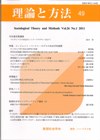Volume 6, Issue 2
Displaying 1-10 of 10 articles from this issue
- |<
- <
- 1
- >
- >|
Special Section : Formal Theories
-
1991Volume 6Issue 2 Pages 2_1
Published: November 01, 1991
Released on J-STAGE: March 31, 2009
Download PDF (49K) -
1991Volume 6Issue 2 Pages 2_3-2_19
Published: November 01, 1991
Released on J-STAGE: March 31, 2009
Download PDF (787K) -
1991Volume 6Issue 2 Pages 2_21-2_36
Published: November 01, 1991
Released on J-STAGE: March 31, 2009
Download PDF (644K) -
1991Volume 6Issue 2 Pages 2_37-2_54
Published: November 01, 1991
Released on J-STAGE: March 31, 2009
Download PDF (571K) -
1991Volume 6Issue 2 Pages 2_55-2_67
Published: November 01, 1991
Released on J-STAGE: March 31, 2009
Download PDF (693K)
Articles
-
1991Volume 6Issue 2 Pages 2_69-2_84
Published: November 01, 1991
Released on J-STAGE: March 31, 2009
Download PDF (621K) -
1991Volume 6Issue 2 Pages 2_85-2_98
Published: November 01, 1991
Released on J-STAGE: March 31, 2009
Download PDF (498K) -
1991Volume 6Issue 2 Pages 2_99-2_113
Published: November 01, 1991
Released on J-STAGE: March 31, 2009
Download PDF (750K)
Letters
-
1991Volume 6Issue 2 Pages 2_115-2_129
Published: November 01, 1991
Released on J-STAGE: March 31, 2009
Download PDF (786K)
Book Reviews
-
1991Volume 6Issue 2 Pages 2_131-2_140
Published: November 01, 1991
Released on J-STAGE: March 31, 2009
Download PDF (555K)
- |<
- <
- 1
- >
- >|
